Clostridioides difficile Infection in an Italian Tertiary Care University Hospital: A Retrospective Analysis
Abstract
1. Introduction
2. Materials and Methods
3. Statistical Analysis
4. Results
5. Discussion
6. Conclusions
Supplementary Materials
Author Contributions
Funding
Institutional Review Board Statement
Informed Consent Statement
Data Availability Statement
Conflicts of Interest
References
- CDC. 2020 HAI Progress Report Executive Summary. 2020. Available online: https://health.gov/our-work/health-care-quality/health-care-associated-infections/targets-metrics (accessed on 1 October 2022).
- European Centre for Disease Prevention and Control. Healthcare-associated infections: Clostridium difficile infections. In Annual Epidemiological Report for 2016; ECDC: Stockholm, Sweden, 2018. [Google Scholar]
- Elliott, B.; Androga, G.O.; Knight, D.R.; Riley, T.V. Clostridium difficile infection: Evolution, phylogeny and molecular epidemiology. Infect. Genet. Evol. 2017, 49, 1–11. [Google Scholar] [CrossRef] [PubMed]
- Davies, K.; Lawrence, J.; Berry, C.; Davis, G.; Yu, H.; Cai, B.; Gonzalez, E.; Prantner, I.; Kurcz, A.; Macovei, I.; et al. Risk Factors for Primary Clostridium difficile Infection; Results From the Observational Study of Risk Factors for Clostridium difficile Infection in Hospitalized Patients With Infective Diarrhea (ORCHID). Front. Public Health 2020, 8, 293. [Google Scholar] [CrossRef] [PubMed]
- Magill, S.S.; O’Leary, E.; Janelle, S.J.; Thompson, D.L.; Dumyati, G.; Nadle, J.; Wilson, L.E.; Kainer, M.A.; Lynfield, R.; Greissman, S.; et al. Changes in Prevalence of Health Care-Associated Infections in U.S. Hospitals. N. Engl. J. Med. 2018, 379, 1732–1744. [Google Scholar] [CrossRef]
- Davies, K.A.; Longshaw, C.M.; Davis, G.L.; Bouza, E.; Barbut, F.; Barna, Z.; Delmée, M.; Fitzpatrick, F.; Ivanova, K.; Kuijper, E.; et al. Underdiagnosis of Clostridium difficile across Europe: The European, multicentre, prospective, biannual, point-prevalence study of Clostridium difficile infection in hospitalised patients with diarrhoea (EUCLID). Lancet Infect. Dis. 2014, 14, 1208–1219. [Google Scholar] [CrossRef] [PubMed]
- di Bella, S.; Musso, M.; Cataldo, M.A.; Meledandri, M.; Bordi, E.; Capozzi, D.; Cava, M.C.; Chiaradonna, P.; Prignano, G.; Petrosillo, N. Clostridium difficile infection in Italian urban hospitals: Data from 2006 through 2011. BMC Infect. Dis. 2013, 13, 146. [Google Scholar] [CrossRef]
- Kwon, J.H.; Olsen, M.A.; Dubberke, E.R. The Morbidity, Mortality, and Costs Associated with Clostridium difficile Infection. Infect. Dis. Clin. N. Am. 2015, 29, 123–134. [Google Scholar] [CrossRef]
- van Prehn, J.; Reigadas, E.; Vogelzang, E.H.; Bouza, E.; Hristea, A.; Guery, B.; Krutova, M.; Norén, T.; Allerberger, F.; Coia, J.E.; et al. European Society of Clinical Microbiology and Infectious Diseases: 2021 update on the treatment guidance document for Clostridioides difficile infection in adults. Clin. Microbiol. Infect. 2021, 27 (Suppl. 2), S1–S21. [Google Scholar] [CrossRef]
- McDonald, L.C.; Gerding, D.N.; Johnson, S.; Bakken, J.S.; Carroll, K.C.; Coffin, S.E.; Dubberke, E.R.; Garey, K.W.; Gould, C.V.; Kelly, C.; et al. Clinical Practice Guidelines for Clostridium difficile Infection in Adults and Children: 2017 Update by the Infectious Diseases Society of America (IDSA) and Society for Healthcare Epidemiology of America (SHEA). Clin. Infect. Dis. 2018, 66, e1–e48. [Google Scholar] [CrossRef]
- van Rossen, T.M.; Ooijevaar, R.E.; Vandenbroucke-Grauls, C.M.J.E.; Dekkers, O.M.; Kuijper, E.J.; Keller, J.J.; van Prehn, J. Prognostic factors for severe and recurrent Clostridioides difficile infection: A systematic review. Clin. Microbiol. Infect. 2022, 28, 321–331. [Google Scholar] [CrossRef]
- Zar, F.A.; Bakkanagari, S.R.; Moorthi, K.M.L.S.T.; Davis, M.B. A Comparison of Vancomycin and Metronidazole for the Treatment of Clostridium difficile-Associated Diarrhea, Stratified by Disease Severity. Clin. Infect. Dis. 2007, 45, 302–307. [Google Scholar] [CrossRef]
- Miller, M.A.; Louie, T.; Mullane, K.; Weiss, K.; Lentnek, A.; Golan, Y.; Kean, Y.; Sears, P. Derivation and validation of a simple clinical bedside score (ATLAS) for Clostridium difficile infection which predicts response to therapy. BMC Infect. Dis. 2013, 13, 148. [Google Scholar] [CrossRef] [PubMed]
- Czepiel, J.; Dróżdż, M.; Pituch, H.; Kuijper, E.J.; Perucki, W.; Mielimonka, A.; Goldman, S.; Wultańska, D.; Garlicki, A.; Biesiada, G. Clostridium difficile infection: Review. Eur. J. Clin. Microbiol. Infect. Dis. 2019, 38, 1211–1221. [Google Scholar] [CrossRef]
- Gabriel, L.; Beriot-Mathiot, A. Hospitalization stay and costs attributable to Clostridium difficile infection: A critical review. J. Hosp. Infect. 2014, 88, 12–21. [Google Scholar] [CrossRef] [PubMed]
- Yu, H.; Alfred, T.; Nguyen, J.L.; Zhou, J.; Olsen, M.A. Incidence, Attributable Mortality, and Healthcare and Out-of-Pocket Costs of Clostridioides difficile Infection in US Medicare Advantage Enrollees. Clin. Infect. Dis. 2022, 76, e1476–e1483. [Google Scholar] [CrossRef] [PubMed]
- Wingen-Heimann, S.M.; Davies, K.; Viprey, V.F.; Davis, G.; Wilcox, M.H.; Vehreschild, M.J.; Lurienne, L.; Bandinelli, P.-A.; Cornely, O.A.; Vilken, T.; et al. Clostridioides difficile infection (CDI): A pan-European multi-center cost and resource utilization study, results from the Combatting Bacterial Resistance in Europe CDI (COMBACTE-CDI). Clin. Microbiol. Infect. 2023, 29, 651.e1–651.e8. [Google Scholar] [CrossRef] [PubMed]
- Petrosillo, N.; Ravasio, R. II Costo Ospedaliero di Trattamento di un Episodio di Infezione da Clostridium difficile in Italia. Glob. Reg. Health Technol. Assess. 2017, 4, 77–83. [Google Scholar] [CrossRef]
- Ministero della Salute del Governo Italiano. La Scheda di Dimissione Ospedaliera (SDO). 2008. Available online: https://www.salute.gov.it/portale/temi/p2_6.jsp?lingua=italiano&id=1232&area=ricoveriOspedalieri&menu=vuoto (accessed on 1 October 2022).
- Centers for Disease Control and Prevention. International Classification of Diseases, Ninth Revision, Clinical Modification (ICD-9-CM). 2021. Available online: https://www.cdc.gov/nchs/icd/icd9cm.htm (accessed on 8 October 2020).
- Hota, S.S.; Achonu, C.; Crowcroft, N.S.; Harvey, B.J.; Lauwers, A.; Gardam, M.A. Determining Mortality Rates Attributable to Clostridium difficile Infection. Emerg. Infect. Dis. 2012, 18, 305–307. [Google Scholar] [CrossRef]
- van Dorp, S.M.; Kinross, P.; Gastmeier, P.; Behnke, M.; Kola, A.; Delmée, M.; Pavelkovich, A.; Mentula, S.; Barbut, F.; Hajdu, A.; et al. Standardised surveillance of Clostridium difficile Infection in European acute care hospitals: A pilot study, 2013. Eurosurveillance 2016, 21, 30293. [Google Scholar] [CrossRef]
- Cataldo, M.A.; Granata, G.; D’Arezzo, S.; Tonziello, G.; Vulcano, A.; De Giuli, C.; Meledandri, M.; Di Caro, A.; Petrosillo, N. Hospitalized patients with diarrhea: Rate of Clostridioides difficile infection underdiagnosis and drivers of clinical suspicion. Anaerobe 2021, 70, 102380. [Google Scholar] [CrossRef]
- Vendrik, K.E.; Baktash, A.; Goeman, J.J.; Harmanus, C.; Notermans, D.W.; de Greeff, S.C.; Kuijper, E.J. Comparison of trends in Clostridioides difficile infections in hospitalised patients during the first and second waves of the COVID-19 pandemic: A retrospective sentinel surveillance study. Lancet Reg. Health Eur. 2022, 19, 100424. [Google Scholar] [CrossRef]
- Sipos, S.; Vlad, C.; Prejbeanu, R.; Haragus, H.; Vlad, D.; Cristian, H.; Dumitrascu, C.; Popescu, R.; Dumitrascu, V.; Predescu, V. Impact of COVID-19 prevention measures on Clostridioides difficile infections in a regional acute care hospital. Exp. Ther. Med. 2021, 22, 1215. [Google Scholar] [CrossRef]
- Ponce-Alonso, M.; de la Fuente, J.S.; Rincón-Carlavilla, A.; Moreno-Nunez, P.; Martínez-García, L.; Escudero-Sánchez, R.; Pintor, R.; García-Fernández, S.; Cobo, J. Impact of the coronavirus disease 2019 (COVID-19) pandemic on nosocomial Clostridioides difficile infection. Infect. Control Hosp. Epidemiol. 2021, 42, 406–410. [Google Scholar] [CrossRef] [PubMed]
- Bentivegna, E.; Alessio, G.; Spuntarelli, V.; Luciani, M.; Santino, I.; Simmaco, M.; Martelletti, P. Impact of COVID-19 prevention measures on risk of health care-associated Clostridium difficile infection. Am. J. Infect. Control 2021, 49, 640–642. [Google Scholar] [CrossRef] [PubMed]
- Hazel, K.; Skally, M.; Glynn, E.; Foley, M.; Burns, K.; O’toole, A.; Boland, K.; Fitzpatrick, F. The other ‘C’: Hospital-acquired Clostridioides difficile infection during the coronavirus disease 2019 (COVID-19) pandemic. Infect. Control Hosp. Epidemiol. 2022, 43, 540–541. [Google Scholar] [CrossRef] [PubMed]
- Ochoa-Hein, E.; Rajme-López, S.; Rodríguez-Aldama, J.C.; Huertas-Jiménez, M.A.; Chávez-Ríos, A.R.; de Paz-García, R.; Haro-Osnaya, A.; González-Colín, K.K.; González-González, R.; González-Lara, M.F.; et al. Substantial reduction of healthcare facility-onset Clostridioides difficile infection (HO-CDI) rates after conversion of a hospital for exclusive treatment of COVID-19 patients. Am. J. Infect. Control 2021, 49, 966–968. [Google Scholar] [CrossRef] [PubMed]
- Granata, G.; Petrosillo, N.; Adamoli, L.; Bartoletti, M.; Bartoloni, A.; Basile, G.; Bassetti, M.; Bonfanti, P.; Borromeo, R.; Ceccarelli, G.; et al. Prospective Study on Incidence, Risk Factors and Outcome of Recurrent Clostridioides difficile Infections. J. Clin. Med. 2021, 10, 1127. [Google Scholar] [CrossRef]
- Esteban-Vasallo, M.D.; de Miguel-Díez, J.; López-de-Andrés, A.; Hernández-Barrera, V.; Jiménez-García, R. Clostridium difficile-related hospitalizations and risk factors for in-hospital mortality in Spain between 2001 and 2015. J. Hosp. Infect. 2019, 102, 148–156. [Google Scholar] [CrossRef]
- CDC. Emerging Infections Program Healthcare-Associated Infections—Community Interface Report Clostridioides difficile Infection; Centers for Disease Control and Prevention: Atlanta, GA, USA, 2018. [Google Scholar]
- Vallabhaneni, S.; Almendares, O.; Farley, M.M.; Reno, J.; Smith, Z.T.; Stein, B.; Magill, S.S.; Smith, R.M.; Cleveland, A.A.; Lessa, F.C. Epidemiology and factors associated with candidaemia following Clostridium difficile infection in adults within metropolitan Atlanta, 2009–2013. Epidemiol. Infect. 2016, 144, 1440–1444. [Google Scholar] [CrossRef] [PubMed]
- Falcone, M.; Tiseo, G.; Venditti, M.; Menichetti, F. Updates in the epidemiology and management of candidemia and Clostridioides difficile coinfection. Expert Rev. Anti-Infect. Ther. 2019, 17, 375–382. [Google Scholar] [CrossRef]
- Thongprayoon, C.; Cheungpasitporn, W.; Phatharacharukul, P.; Mahaparn, P.; Bruminhent, J. High Mortality Risk in Chronic Kidney Disease and End Stage Kidney Disease Patients with Clostridium difficile Infection: A Systematic Review and Meta-analysis. S. Pac. J. Nat. Appl. Sci. 2015, 1, e85. [Google Scholar]
- Phatharacharukul, P.; Thongprayoon, C.; Cheungpasitporn, W.; Edmonds, P.J.; Mahaparn, P.; Bruminhent, J. The Risks of Incident and Recurrent Clostridium difficile-Associated Diarrhea in Chronic Kidney Disease and End-Stage Kidney Disease Patients: A Systematic Review and Meta-Analysis. Dig. Dis. Sci. 2015, 60, 2913–2922. [Google Scholar] [CrossRef] [PubMed]
- Radhakrishnan, P.; Vishwanath, M.; Shemin, D.; Monteiro, J.F.G.; D’agata, E.M. Clostridioides difficile Infection Among Patients Requiring Maintenance Hemodialysis. Kidney Med. 2021, 3, 467–470. [Google Scholar] [CrossRef]
- Elfanagely, Y.M.; Tanzer, J.R.; Shobayo, A.; Mohamed, M.F.; Ho, J.J.; Shemin, D.; Pavlech, L.; D’agata, E.M. Prevalence and trends of Clostridioides difficile infection among persons requiring maintenance hemodialysis: A systematic review and meta-analysis. Infect. Control Hosp. Epidemiol. 2022, 1–8. [Google Scholar] [CrossRef] [PubMed]
- Tirath, A.; Tadros, S.; Coffin, S.L.; Kintziger, K.W.; Waller, J.L.; Baer, S.L.; Colombo, R.E.; Huber, L.Y.; Kheda, M.F.; Nahman, N.S., Jr. Clostridium difficile Infection in Dialysis Patients. J. Investig. Med. 2017, 65, 353–357. [Google Scholar] [CrossRef] [PubMed]
- Pant, C.; Deshpande, A.; Anderson, M.P.; Sferra, T.J. Clostridium difficile Infection is Associated with Poor Outcomes in End-Stage Renal Disease. J. Investig. Med. 2012, 60, 529–532. [Google Scholar] [CrossRef]
- Sheth, H.; Bernardini, J.; Burr, R.; Lee, S.; Miller, R.G.; Shields, M.; Vergis, E.N.; Piraino, B. Clostridium difficile Infections in Outpatient Dialysis Cohort. Infect. Control Hosp. Epidemiol. 2010, 31, 89–91. [Google Scholar] [CrossRef]
- Shin, J.; Wi, Y.M.; Lee, Y.-J. Metronidazole therapy as initial treatment of Clostridium difficile infection in patients with chronic kidney disease in Korea. Epidemiol. Infect. 2019, 147, e289. [Google Scholar] [CrossRef]
- Ramesh, M.S.; Yee, J. Clostridioides difficile Infection in Chronic Kidney Disease/End-Stage Renal Disease. Adv. Chronic Kidney Dis. 2019, 26, 30–34. [Google Scholar] [CrossRef]
- Pépin, J.; Alary, M.-E.; Valiquette, L.; Raiche, E.; Ruel, J.; Fulop, K.; Godin, D.; Bourassa, C. Increasing Risk of Relapse after Treatment of Clostridium difficile Colitis in Quebec, Canada. Clin. Infect. Dis. 2005, 40, 1591–1597. [Google Scholar] [CrossRef]
- Chakra, C.N.A.; Pepin, J.; Sirard, S.; Valiquette, L. Risk Factors for Recurrence, Complications and Mortality in Clostridium difficile Infection: A Systematic Review. PLoS ONE 2014, 9, e98400. [Google Scholar] [CrossRef]
- Cornely, O.A.; Miller, M.A.; Fantin, B.; Mullane, K.; Kean, Y.; Gorbach, S. Resolution of Clostridium difficile–Associated Diarrhea in Patients With Cancer Treated With Fidaxomicin or Vancomycin. J. Clin. Oncol. 2013, 31, 2493–2499. [Google Scholar] [CrossRef] [PubMed]
- Mullane, K.M.; Miller, M.A.; Weiss, K.; Lentnek, A.; Golan, Y.; Sears, P.S.; Shue, Y.-K.; Louie, T.J.; Gorbach, S.L. Efficacy of Fidaxomicin Versus Vancomycin as Therapy for Clostridium difficile Infection in Individuals Taking Concomitant Antibiotics for Other Concurrent Infections. Clin. Infect. Dis. 2011, 53, 440–447. [Google Scholar] [CrossRef] [PubMed]
- Giacobbe, D.R.; Vena, A.; Falcone, M.; Menichetti, F.; Bassetti, M. Fidaxomicin for the Treatment of Clostridioides difficile Infection in Adult Patients: An Update on Results from Randomized Controlled Trials. Antibiotics 2022, 11, 1365. [Google Scholar] [CrossRef] [PubMed]
- Meschiari, M.; Cozzi-Lepri, A.; Cervo, A.; Granata, G.; Rogati, C.; Franceschini, E.; Casolari, S.; Tatarelli, P.; Giacobbe, D.R.; Bassetti, M.; et al. Efficacy of bezlotoxumab in preventing the recurrence of Clostridioides difficile infection: An Italian multicenter cohort study. Int. J. Infect. Dis. 2023, 131, 147–154. [Google Scholar] [CrossRef]
- Pipitone, G.; Granata, G.; Sartelli, M.; Gizzi, A.; Imburgia, C.; Cascio, A.; Iaria, C. Intravenous metronidazole for fulminant Clostridioides difficile infection. Clin. Microbiol. Infect. 2023, 29, 656–657. [Google Scholar] [CrossRef]
- Medaglia, A.A.; Buffa, S.; Gioè, C.; Bonura, S.; Rubino, R.; Iaria, C.; Colomba, C.; Cascio, A. An emergent infectious disease: Clostridioides difficile infection hospitalizations, 10-year trend in Sicily. Infection 2021, 49, 1221–1229. [Google Scholar] [CrossRef]
- Colomb-Cotinat, M.; Assouvie, L.; Durand, J.; Daniau, C.; Leon, L.; Maugat, S.; Soing-Altrach, S.; Gateau, C.; Couturier, J.; Arnaud, I.; et al. Epidemiology of Clostridioides difficile infections, France, 2010 to 2017. Eurosurveillance 2019, 24, 1800638. [Google Scholar] [CrossRef]
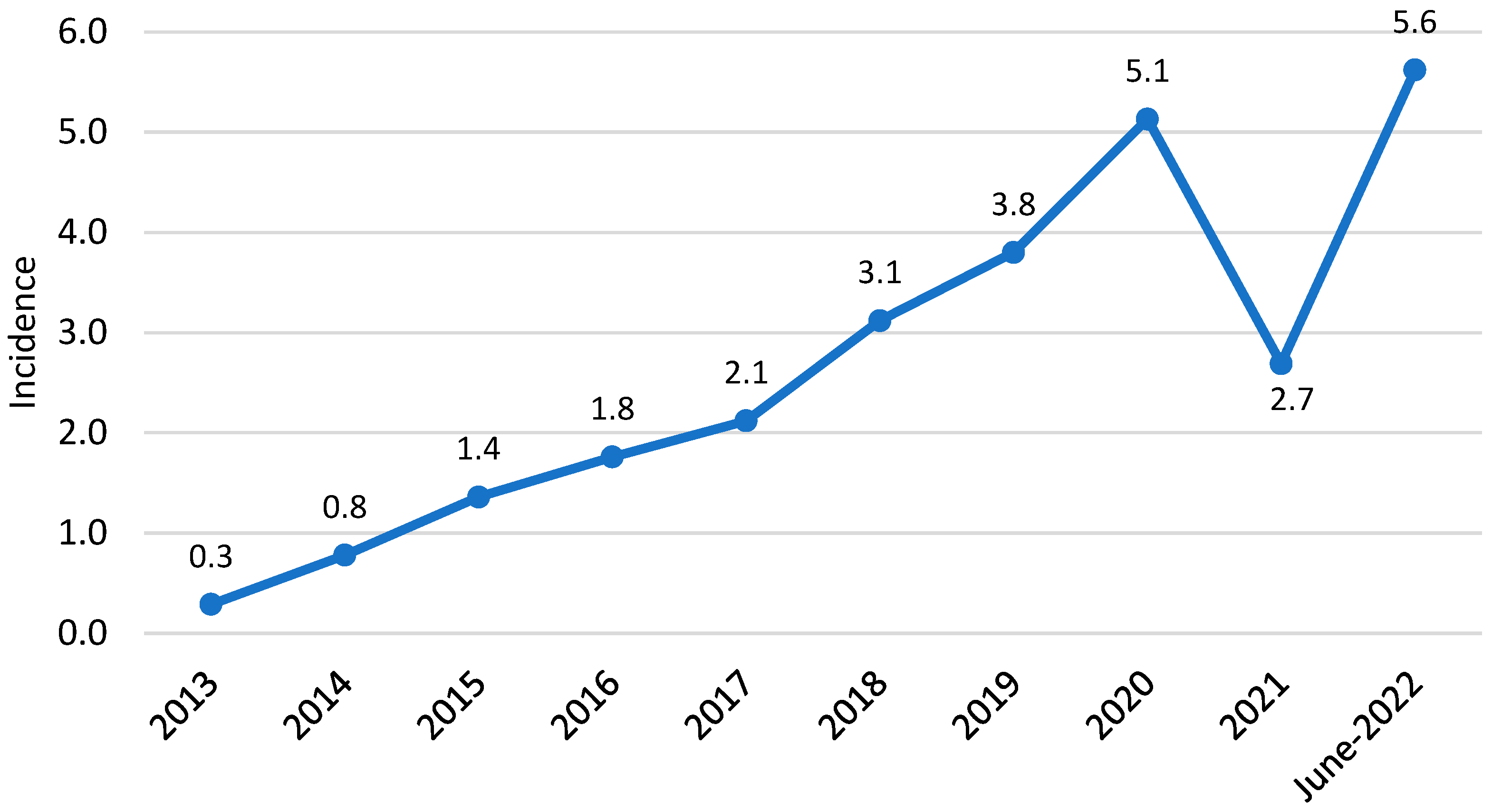
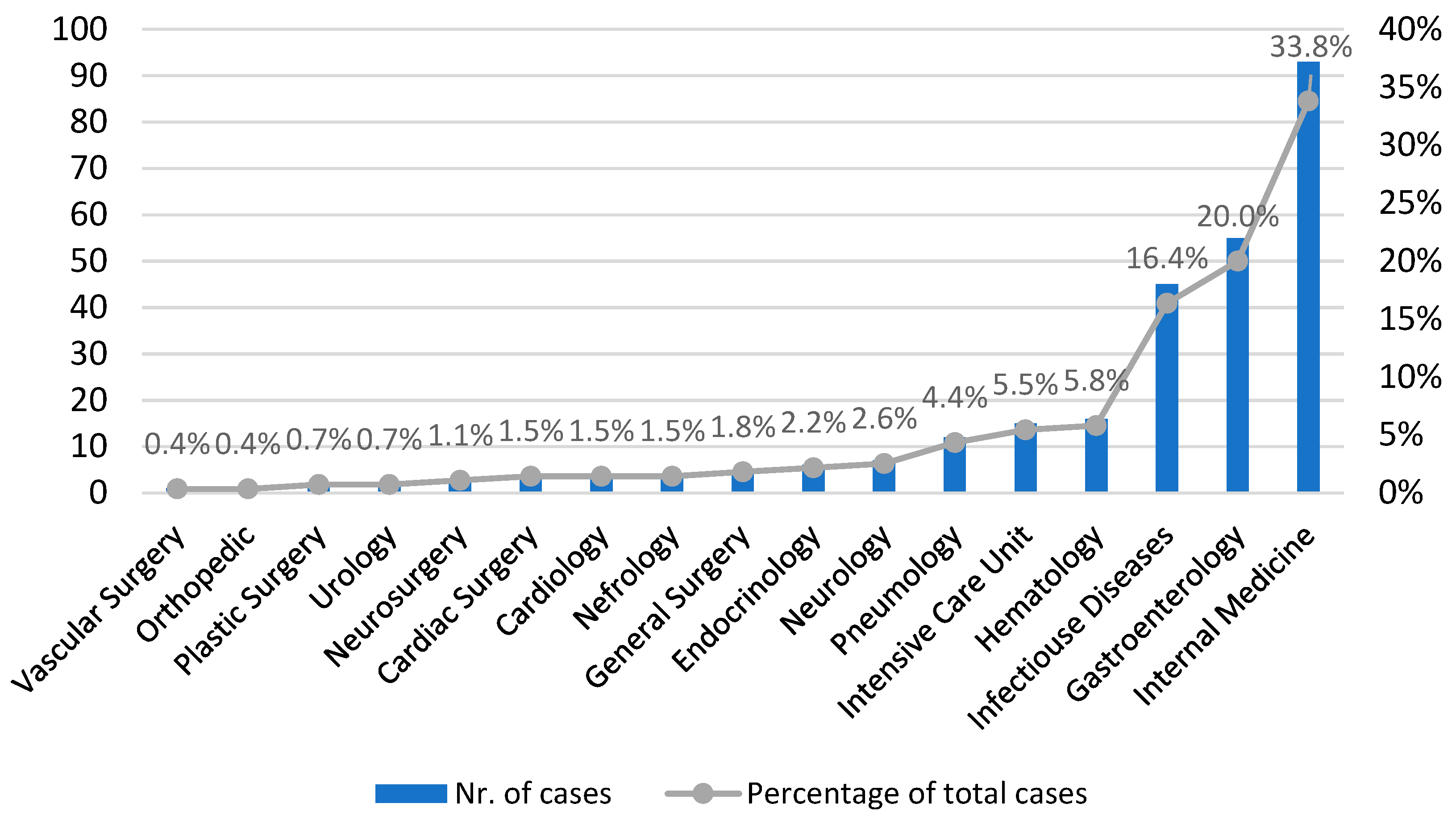
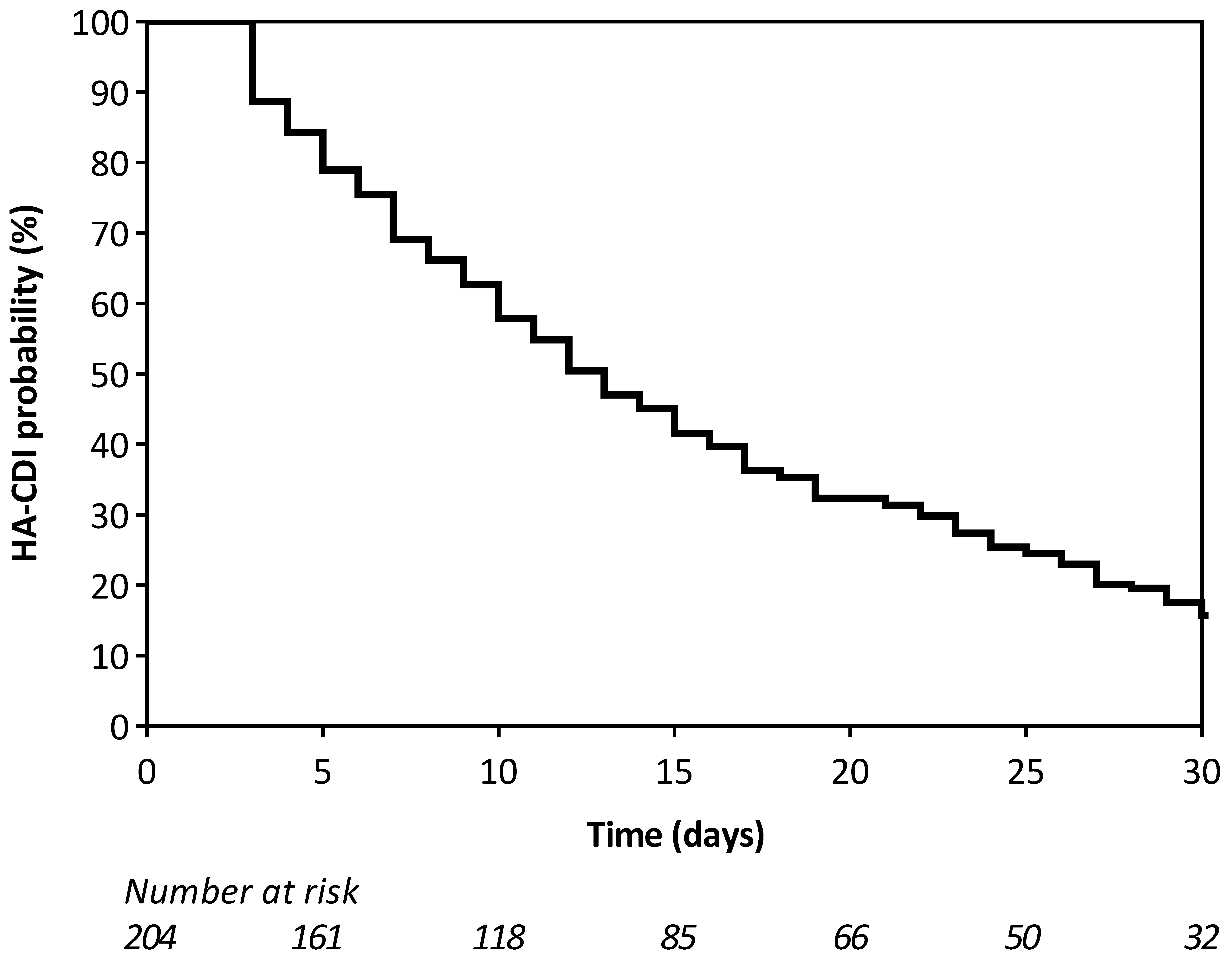
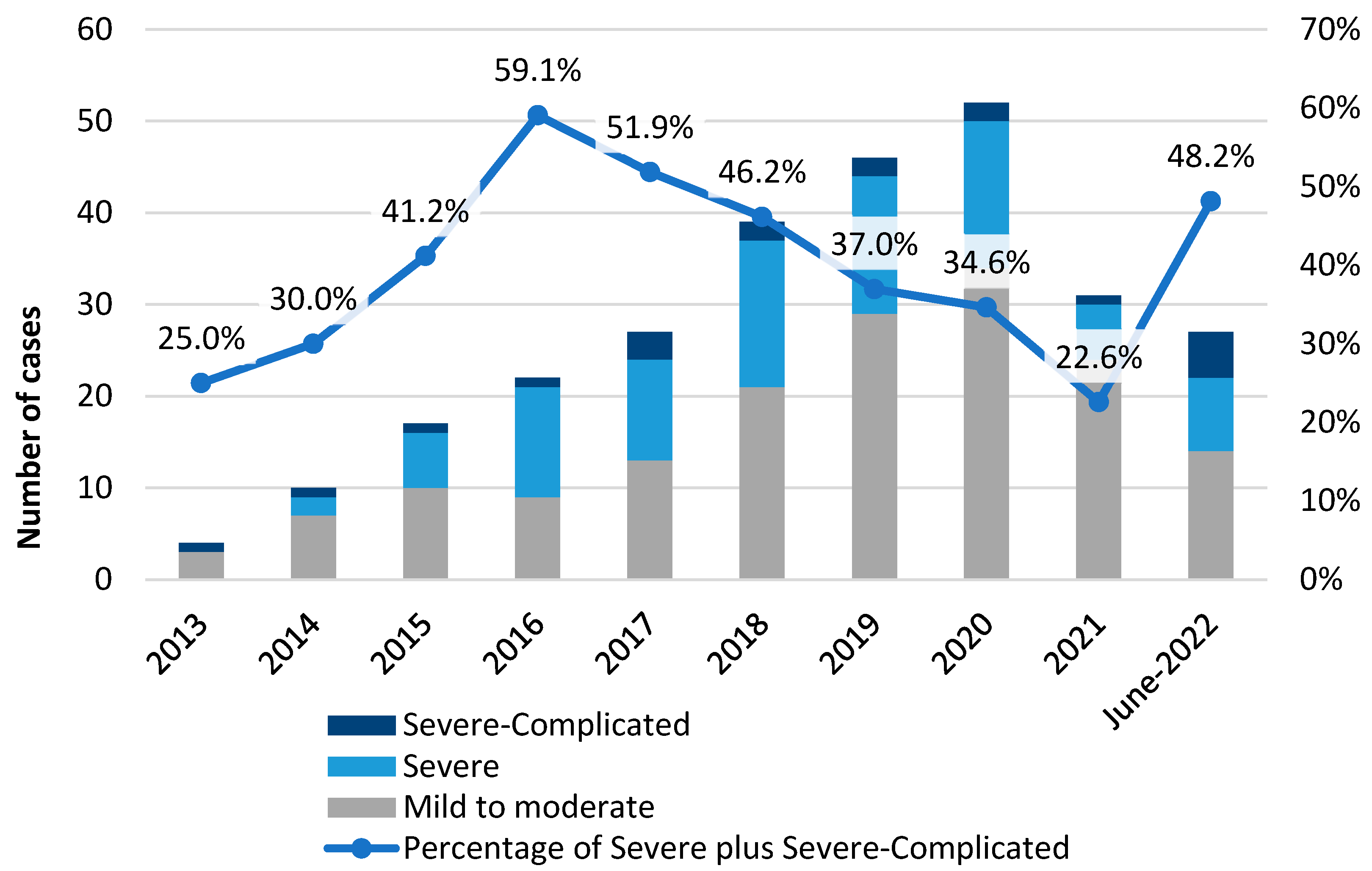
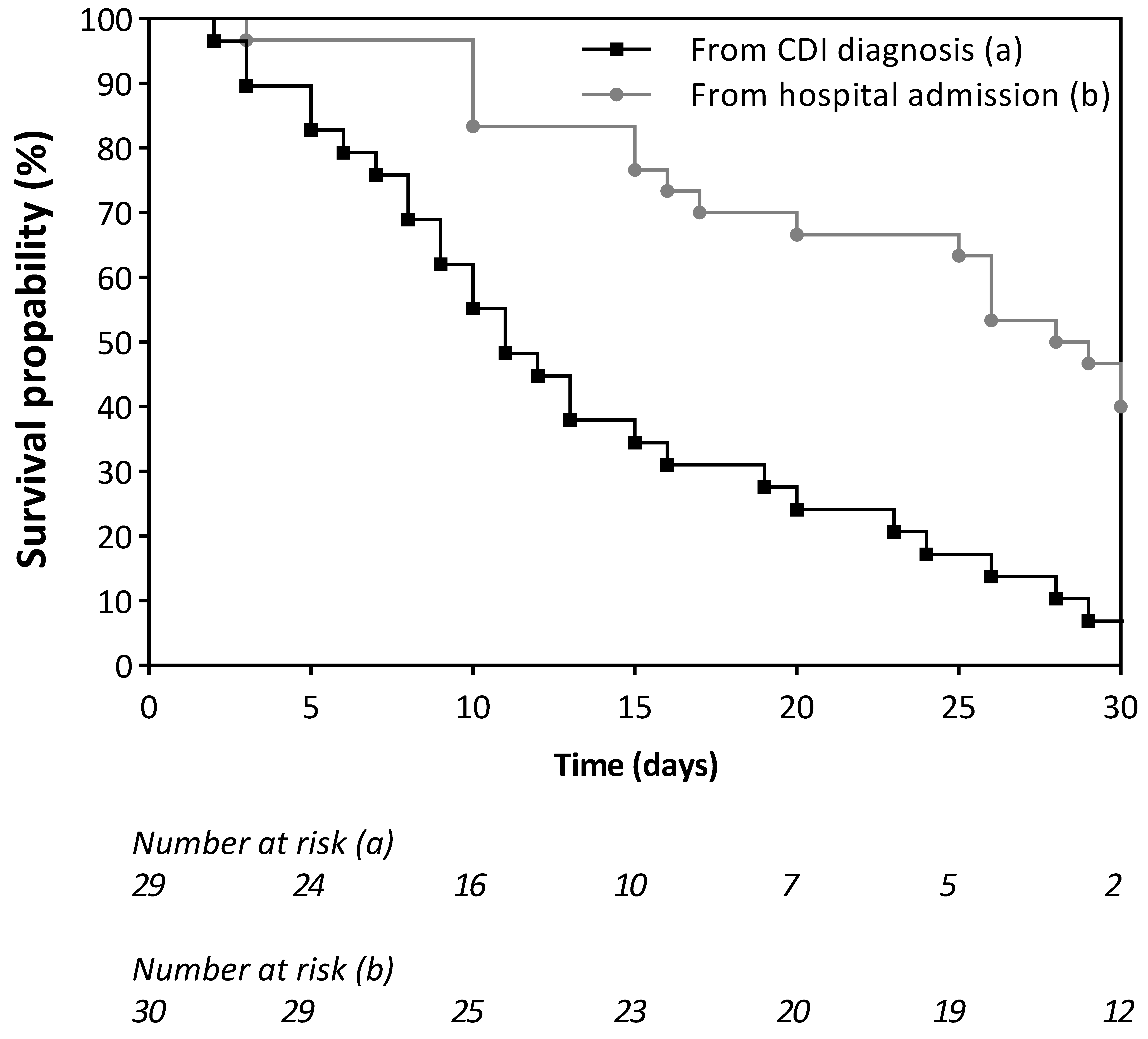
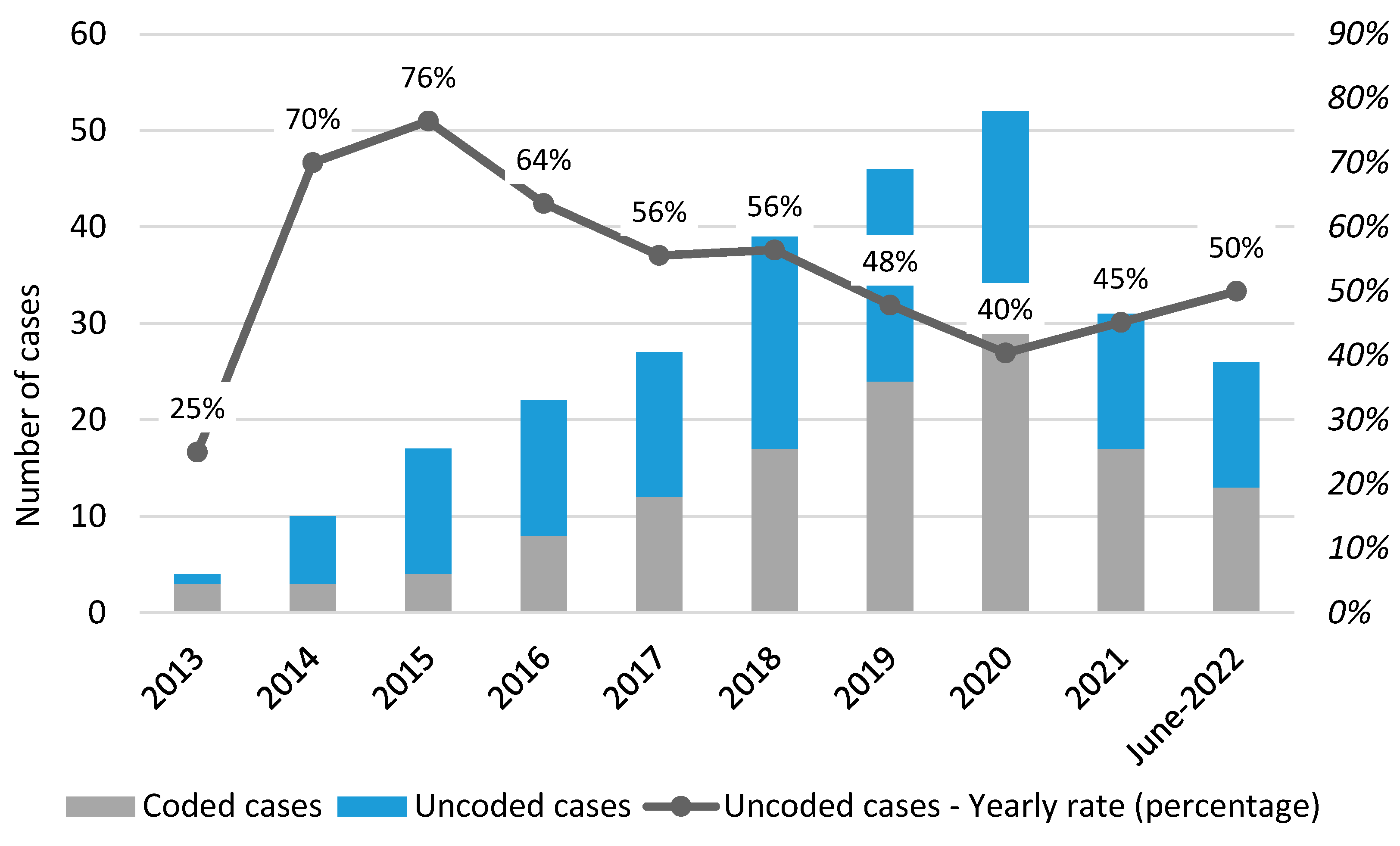
| Outcome Clinical | |||||||||
|---|---|---|---|---|---|---|---|---|---|
| Variables | All (n:275) | Alive (n:244) | Dead (n:31) | Crude Or (CI 95%) | AOR (CI 95%) | p-Value | No Recurrence (n:264) | Recurrence (n:11) | p-Value |
| Epidemiological characteristics | |||||||||
| Male | 120 (43.6%) | 108 (44.3%) | 12 (38.7%) | 1 | 116 (43.9%) | 4 (36.4%) | |||
| Female | 155 (56.4%) | 136 (55.7%) | 19 (61.3%) | 1.3 (0.6–2.7) | 148 (56.1%) | 7 (63.6%) | |||
| Age (average ± STD) <57 ≥57 | 65.8 ± 18.4 73 (26.5%) 202 (73.5%) | 65.2 ± 19.1 69 (28.3%) 175 (71.7%) | 71.2 ± 10.7 4 (12.9%) 27 (87.1%) | 1 2.7 (0.90–7.9) | 65.7 ± 18.4 72 (27.2%) 192 (72.7%) | 69.1 ± 16.9 1 (9.1%) 10 (90.9%) | |||
| Nationality | |||||||||
| Italian Not Italian | 265 (96.4%) 10 (3.6%) | 235 (96.3%) 9 (3.7%) | 30 (96.8%) 1 (3.2%) | 1 0.9 (0.1–7.1) | 256 (97.0%) 8 (3.0%) | 9 (81.8%) 2 (18.2%) | 0.228 | ||
| Outcome | |||||||||
| LOS median (IQR) | 22 (12–39) | 21 (12–39) | 28 (15–50) | 22 (12–38) | 41 (18–56 | ||||
| <25 ≥25 | 149 (54.2%) 126 (45.8%) | 138 (56.6%) 106 (43.4%) | 11 (35.5%) 20 (64.5%) | 1 2.4 (1.1–5.1) | 1 2.7 (1–7.4) | 0.057 | 146 (55.4%) 118 (44.7%) | 3 (27.2%) 8 (72%) | 0.076 |
| Recurrence No Yes | 264 (96.0%) 11 (4.0%) | 264 (95.9%) 10 (4.1%) | 30 (96.8%) 1 (3.2%) | 1 0.8 (0.1–6.3) | - | - | |||
| Risk factors and comorbidities | |||||||||
| CCI (average ± STD) <5 ≥5 | 5.3 ± 2.8 91 (33.1%) 184 (66.9%) | 5.1 ± 2.9 88 (36.1%) 156 (63.9%) | 6.3 ± 1.7 3 (9.7%) 28 (90.3%) | 1 5.3 (1.6–17.8) | 5 ± 3 90 (34%) 176 (66%) | 7 ± 4 3 (27%) 8 (72.7%) | |||
| Chronic kidney disease (n:275) | 203 (76%) 61 (23.1%) | 7 (63.6%) 4 (36.4%) | |||||||
| No Yes | 210 (76.4%) 65 (23.6%) | 187 (76.6%) 57 (23.4%) | 23 (74.2%) 8 (25.8%) | 1 1.1 (0.5–2.7) | |||||
| Hemodialysis (n:275) | |||||||||
| No Yes | 259 (94.2%) 16 (5.8%) | 236 (96.7%) 8 (3.3%) | 23 (74.2%) 8 (25.8%) | 1 10.3(3.5–29.9) | 1 7.6 (2–27.3) | 0.001 | 249 (94.3%) 15 (5.7%) | 10 (90.1%) 1 (9.1%) | |
| Diabetes mellitus II (n:275) | 211 (79.9%) 53 (20.1%) | 8 (72.7%) 3 (27.3%) | |||||||
| No Yes | 219 (79.6%) 56 (20.4%) | 195 (79.9%) 49 (20.1%) | 24 (77.4%) 7 (22.6%) | 1 1.2 (0.5–2.8) | |||||
| Chronic liver disease (n:275) | |||||||||
| No Yes | 236 (85.8%) 39 (14.2%) | 209 (85.7%) 35 (14.3%) | 27 (87.1%) 4 (12.9%) | 1 0.9 (0.3–2.7) | 226 (85.6%) 38 (14.4%) | 10 (90.1%) 1 (9.1%) | |||
| Immunosuppression (n:275) | 230 (87.1%) 34 (12.9%) | 10 (90.1%) 1 (9.1%) | |||||||
| No Yes | 240 (87.3%) 35 (12.7%) | 215 (88.1%) 29 (11.9%) | 25 (80.6%) 6 (19.4%) | 1 1.8 (0.7–4.7) | |||||
| Inflammatory bowel disease (n:275) | |||||||||
| No Yes | 240 (87.3%) 35 (12.7%) | 210 (86.1%) 34 (13.9%) | 30 (96.8%) 1 (3.2%) | 1 0.2 (0–1.6) | 230 (87.1%) 34 (12.9%) | 10 (90.1%) 1 (9.1%) | |||
| Previous infections (n:266) | |||||||||
| No Yes | 88 (33.1%) 178 (66.9%) | 83 (35.3%) 152 (64.7%) | 5 (16.1%) 26 (83.9%) | 1 2.9 (1–7.7) | 1 0.7 (0.2–2.4) | 0.539 | 87 (34.1%) 168 (65.9%) | 1 (9.1%) 10 (90.1%) | |
| Use of antibiotics (n:138) | |||||||||
| No Yes | 14 (10.1%) 124 (89.9%) | 10 (9.3%) 97 (90.7%) | 4 (12.9%) 27 (87.1%) | 1 0.7 (0.2–2.4) | 12 (9.4%) 115 (90.6%) | 2 (18.1%) 9 (81.8%) | |||
| Use of PPI (n:111) | 24 (25.5%) 76 (74.5%) | 5 (45.5%) 6 (54.5%) | |||||||
| No Yes | 29 (26.1%) 82 (73.9%) | 21 (22.1%) 74 (77.9%) | 8 (50%) 8 (50%) | 1 0.3 (0.1–0.8) | |||||
| Clinical features | |||||||||
| Diarrhea (n:136) | |||||||||
| No Yes | 7 (5.1%) 129 (94.9%) | 5 (4.4%) 108 (95.6%) | 2 (8.7%) 21 (91.3%) | 1 0.5 (0.1–2.7) | 7 (5.6%) 118 (94.4%) | 0 (0%) 11 (100%) | |||
| Abdominal pain (n:135) | |||||||||
| No Yes | 92 (68.1%) 43 (31.9%) | 76 (67.9%) 36 (32.1%) | 16 (69.6%) 7 (30.4%) | 1 0.9 (0.3–2.4) | 84 (67.7%) 40 (32.3%) | 8 (72.7%) 3 (27.3%) | |||
| Fever (n:275) | 168 (63.3%) 96 (36.4%) | 11 (100%) 0 (0%) | 0.996 | ||||||
| No Yes | 179 (65.1%) 96 (34.9%) | 163 (66.8%) 81 (33.2%) | 16 (51.6%) 15 (48.4%) | 1 1.9 (0.9–4) | |||||
| Vomit (n:135) | |||||||||
| No Yes | 124 (91.9%) 11 (8.1%) | 106 (94.6%) 6 (5.4%) | 18 (78.3%) 5 (21.7%) | 1 4.9 (1.3–17.8) | 113 (91.8%) 11 (8.9%) | 11 (100%) 0 (0%) | |||
| Ileum (n: 135) | 120 (96%) 5 (4.0%) | 10 (100%) 0 (0%) | |||||||
| No Yes | 130 (96.3%) 5 (3.7%) | 108 (96.4%) 4 (3.6%) | 22 (95.7%) 1 (4.3%) | 1 1.2 (0.1–11.5) | |||||
| Pseudomembranes (n:275) | |||||||||
| No Yes | 268 (97.5%) 7 (2.5%) | 237 (97.1%) 7 (2.9%) | 31 (100%) 0 (0%) | 1 - | 258 (97.7%) 6 (2.3%) | 10 (90.9%) 1 (9.1%) | |||
| Shock (n:275) | 251 (95.1%) 13 (4.9%) | 11 (100%) 0 (0%) | |||||||
| No Yes | 262 (95.3%) 13 (4.7%) | 241 (98.8%) 3 (1.2%) | 21 (67.7%) 10 (32.3%) | 1 38.2 (9.8–149.8) | |||||
| Intensive care unit stay (n:273) | |||||||||
| No Yes | 266 (97.4%) 7 (2.6%) | 242 (99.6%) 1 (0.4%) | 24 (80.0%) 6 (20.0%) | 1 60.5 (10–523.6) | 256 (97.7%) 6 (2.3%) | 10 (90.9%) 1 (9.1%) | |||
| Other infections—Candidemia (n:270) | |||||||||
| No Yes | 266 (98.5%) 4 (1.5%) | 237 (98.3%) 4 (1.7%) | 29 (100%) 0 (0%) | 1 - | 255 (98.5%) 4 (1.5%) | 11 (100%) 0 (0%) | |||
| Severity according to Zar score (n:242) | |||||||||
| <2 ≥2 | 166 (68.6%) 76 (31.4%) | 155 (72.8%) 58 (27.2%) | 11 (37.9%) 18 (62.1%) | 1 4.4 (1.9–9.8) | 160 (69.2%) 71 (30.3%) | 6 (54.5%) 5 (45.4%) | |||
| Severity according to ESCMID 2021 definition (n:275) | |||||||||
| Not severe Severe/complicated | 164 (59.6%) 111 (40.4%) | 159 (65.2%) 85 (34.8%) | 5 (16.1%) 26 (83.9%) | 1 9.7 (3.6–26.2) | 157 (59.5%) 107 (40.5%) | 7 (63.6%) 4 (36.4%) | |||
| ATLAS score (n:130) | |||||||||
| ≤5 >5 | 105 (80.8%) 25 (19.2%) | 84 (83.2%) 17 (16.7%) | 21 (72.4%) 8 (27.6%) | 1 1.9 (0.7–4.9) | 1 1.6 (0.5–4.6) | 0.406 | 96 (80.7%) 23 (19.3%) | 9 (81.8%) 2 (18.2%) | |
| Laboratory tests | |||||||||
| White blood cells (n:275) | |||||||||
| Average ± STD <12,880 ≥12,880 | 10,9 ± 10.4 191 (69.5%) 84 (30.5%) | 9.9 ± 7.6 177 (72.5%) 67 (27.5%) | 18.5 ± 21 14 (45.2%) 17 (54.8%) | 1 3.2 (1.5–6.9) | 10,9 ± 10,5 182 (69%) 82 (31%) | 10,5 ± 5,0 9 (81.8%) 2 (18.2%) | |||
| Basal creatinine (n:273) | |||||||||
| Average ± STD <0.96 ≥0.96 | 1.19 ± 1.0 154 (56.4%) 119 (43.6%) | 1.1 ± 1.0 143 (59.1%) 99 (40.9%) | 1.5 ± 1.4 11 (35.5%) 20 (64.5%) | 1 2.6 (1.2–5.7) | 1.1 ± 1.0 148 (56.4%) 114 (46.6%) | 1.2 ± 1.0 6 (54.5%) 5 (45.5%) | |||
| Creatinine during infection (n: 273) | |||||||||
| Average ± STD <1.87 ≥1.87 | 1.3 ± 1.2 233 (85.3%) 40 (14.7%) | 1.2 ± 1.1 214 (88.4%) 28 (11.6%) | 1.9 ± 1.7 19 (61.3%) 12 (38.7%) | 1 4.8 (2.1–11.1) | 1.3 ± 1.2 225 (88.9%) 37 (14.1%) | 1.1 ± 0.7 8 (72.7%) 3 (27.2%) | |||
| Increase (%) in creatinine from baseline (n:273) | |||||||||
| Average ± STD <42% ≥42% | 14.1 ± 51.4 137 (50.4%) 135 (49.6%) | 10.3 ± 37 126 (52.3%) 115 (47.7%) | 43.5 ± 109.2 11 (35.5%) 20 (64.5%) | 1 2 (0.9–4.3) | 14.1 ± 51.7 127 (48.6%) 134 (51.4%) | 12.0 ± 45.4 10 (90.9%) 1 (9.1%) | |||
| Albumin during infection (n:243) | 3.0 ± 0.64 141 (60.8%) 91 (39.2%) | 2.7 ± 0.4 3 (27.3%) 8 (72.7%) | |||||||
| Average ± STD >2.80 ≤2.80 | 3 ± 0.6 144 (59.3%) 99 (40.7%) | 3 ± 0.64 133 (62.1%) 81 (37.9%) | 2.71 ± 0.53 11 (37.9%) 18 (62.1%) | 1 2.7 (1.2–6) | |||||
| Antibiotic therapy for CDI (n:136) | |||||||||
| Fidaxomicin Metronidazole Vancomycin | 23 (17%) 15 (11%) 98 (72%) | 10 (10.1%) 13 (13.1%) 76 (76.8%) | 13 (35.2%) 2 (5.4%) 22 (59.4%) | 0.08 (0.0–0.2) 0.07 (0.0–0.2) 0.09 (0.0–0.1) | 21 (16.8%) 15 (12%) 89 (71.2%) | 2 (18.2%) 0 (0%) 9 (81.8%) | |||
Disclaimer/Publisher’s Note: The statements, opinions and data contained in all publications are solely those of the individual author(s) and contributor(s) and not of MDPI and/or the editor(s). MDPI and/or the editor(s) disclaim responsibility for any injury to people or property resulting from any ideas, methods, instructions or products referred to in the content. |
© 2023 by the authors. Licensee MDPI, Basel, Switzerland. This article is an open access article distributed under the terms and conditions of the Creative Commons Attribution (CC BY) license (https://creativecommons.org/licenses/by/4.0/).
Share and Cite
Medaglia, A.A.; Mancuso, A.; Albano, C.; Zinna, G.; Pipitò, L.; Calà, C.; Immordino, R.; Rubino, R.; Bonura, S.; Canino, B.; et al. Clostridioides difficile Infection in an Italian Tertiary Care University Hospital: A Retrospective Analysis. Antibiotics 2023, 12, 837. https://doi.org/10.3390/antibiotics12050837
Medaglia AA, Mancuso A, Albano C, Zinna G, Pipitò L, Calà C, Immordino R, Rubino R, Bonura S, Canino B, et al. Clostridioides difficile Infection in an Italian Tertiary Care University Hospital: A Retrospective Analysis. Antibiotics. 2023; 12(5):837. https://doi.org/10.3390/antibiotics12050837
Chicago/Turabian StyleMedaglia, Alice Annalisa, Alessandro Mancuso, Chiara Albano, Giuseppe Zinna, Luca Pipitò, Cinzia Calà, Rita Immordino, Raffaella Rubino, Silvia Bonura, Baldassare Canino, and et al. 2023. "Clostridioides difficile Infection in an Italian Tertiary Care University Hospital: A Retrospective Analysis" Antibiotics 12, no. 5: 837. https://doi.org/10.3390/antibiotics12050837
APA StyleMedaglia, A. A., Mancuso, A., Albano, C., Zinna, G., Pipitò, L., Calà, C., Immordino, R., Rubino, R., Bonura, S., Canino, B., Calamusa, G., Colomba, C., Almasio, P. L., & Cascio, A. (2023). Clostridioides difficile Infection in an Italian Tertiary Care University Hospital: A Retrospective Analysis. Antibiotics, 12(5), 837. https://doi.org/10.3390/antibiotics12050837









